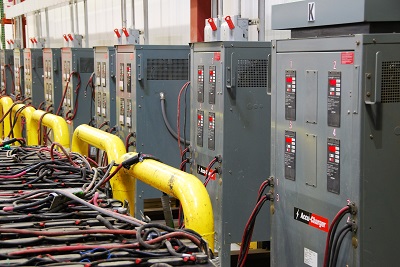In observation of National Forklift Safety Day on June 12, Ametek Prestolite Power, a leading industrial battery charging solutions provider, is reminding material handling industry participants at all levels about the need to put safety first in their forklift fleet – as well as their batteries and chargers – within all operations.
According to the National Institute for Occupational Safety and Health (NIOSH), the most common forklift injuries occur when workers are hit, struck, crushed or pinned by the vehicle or fall from one. Also at the top of the list are burns and electrocutions resulting from accidental fires, explosions and mishaps involving lift truck batteries and chargers.
“Electric forklift batteries and charging operations are extremely safe when properly implemented and all relevant safety procedures and maintenance regimens are followed,” says Jeff Harrison, Business Manager for AMETEK Prestolite Power. “Above all, training and preparation is key to ensuring the highest level of safety possible for your personnel and property.”
In addition to ensuring a warehouse has proper in-house safety signage, forklift operators need to make sure to assign staff members to a safety team to ensure compliance with local, state and federal regulations. OSHA, for instance, points to four primary hazards associated with batteries and chargers:
● Weight – Lift truck batteries are heavy and pose a threat when suspended by battery handling equipment.
● Caustic fluids – Electrolytes in lead-acid battery cells contain hazardous levels of sulfuric acid.
● Gasses – During charging, batteries emit hydrogen gas and when levels get too high they can burst into flames or explode.
● Exposure to electricity – Active battery cells hold an electrical charge, which can short circuit when touched by an employee, causing electrical burns. Arcing also increases the risk of explosion.
The following is a set of guidelines for helping to reduce forklift- and battery charging-related accidents:
1) Separate the battery changing area or “battery room” from general warehouse traffic and make sure it is adequately ventilated.
2) Protect battery handling equipment with highly visible structural barriers and floors that are level, flat and acid-resistant.
3) Equip each battery room with battery wash and eye wash stations, spill kits and hydrogen gas detectors. Have available plenty of water, soda ash, baking soda and CO2, dry chemical or foam fire extinguishers.
4) Wear the right protective gear, including safety goggles, face shields, rubber or neoprene gloves and aprons.
5) Remove anything metallic, including jewelry, and keep metal objects away from uncovered batteries.
6) Take precautions with flammable materials.
7) Check electrolyte and water levels before beginning active charging, but don’t add water until after charging is complete.
8) When mixing the electrolyte, always pour acid into water, not the other way around, and pour slowly.
9) Keep the charger turned off and unplugged while attaching or detaching clamp connections.
10) For batteries with sealed vents, don’t exceed 25 amperes of current.
11) If the battery heats up, or if vents start leaking fluid, turn off the charger and start over with a lower rate of charge.
12) Keep water levels at the indicated height, but only add the deionized water after recharging is complete.
13) Record all levels in a designated service log.
14) Have regular preventative maintenance or have a qualified dealer perform that service.
Article topics








